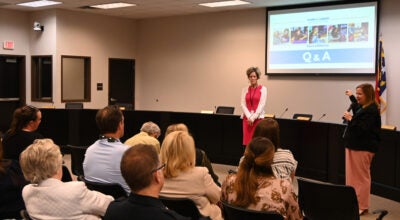Rebecca Rider column: Techno tips
Published 12:00 am Thursday, November 17, 2016
SALISBURY — If there’s one thing we’ve learned in the last century or so, it’s that technology changes — fast. Just a little over a hundred years ago, people harnessed the power of flight. Now, we send people to space and have the ability to print organs.
“And today in California, there are cars that drive themselves,” Andrew Smith, director of digital innovation with Rowan-Salisbury Schools, said Tuesday.
That’s one reason Rowan-Salisbury Schools has started hosting parent talks throughout the school year. The workshops alternate topics — either giving literacy strategies or giving parents tips for dealing with a child who brings home a school-issued device.
Tuesday, the topic was technology. Smith, who led the workshop, started off by talking about how much the world had changed since the start of the 19th century. Everything — transportation, communication and medicine — has undergone nearly unrecognizable change. Except for education.
In most classrooms, the set up, with its rows of desks and board, still resembles pioneer schools. But the factory and mill jobs those rows prepared students for no longer exist, and a worksheet of simple, linear equations can now be solved by an easily-accessible mobile app.
Education has had to change. For Rowan-Salisbury Schools, that’s meant turning classrooms into round tables for discussion, turning those simple math problems into word problems or real-world problems and giving each student access to a laptop or iPad.
Each day approximately 17,000 Rowan County students walk around, carrying a device that gives them access to the entire collective knowledge of the human race. For free.
As they say, with great power comes great responsibility.
For the average high school senior, that access is something that they might take for granted. Their parents, on the other hand, might not even be aware of it — or consider the pitfalls it can bring.
Many students might be lured by the perceived anonymity of the internet and think that there are no consequences — that they can do or say whatever they want.
“It seems a little bit like the Wild West,” he said.
But the opposite is true. The school system tries to hammer home that what you say or do on the internet impact you in real life. Even services like Snapchat — where users send a picture that “vanishes” in 10 seconds — store and archive information on servers that may be vulnerable to attack. Put simply: Nothing you put on the internet disappears.
“There’s always a trace on the internet,” he said.
On Tuesday, Smith encouraged parents to talk to their children about this issue, and to be aware of their students’ browsing habits. Discussions about things like sexting and sites to avoid might be awkward, but they’re necessary.
“They’re the conversations you need to have with your kids,” he said.
Smith laid out some best practices for parents dealing with technology:
- Check a student’s internet history frequently.
- Have an open-door policy
- Know student passwords to websites.
It’s also important for parents to know which social media sites their children are on, and to be aware that some sites and apps — such as 4chan, Snapchat and chatroulette sites like Omegle
However, services like Twitter, Facebook and Instagram are often useful for classroom teachers to share student’s work, he said.
Smith also added that students should never say where they live or where they are on any social media platform.
Many parents have expressed concern with students using the devices to goof off during class, instead of doing their work. According to Smith, the school system will soon be getting a program called Apple Classroom, which will allow a teacher to simultaneously view all of his or her students’ screens and keep track of who is off task.
When it comes to other concerns or information, Smith recommended parents visit www.commonsensemedia.com


